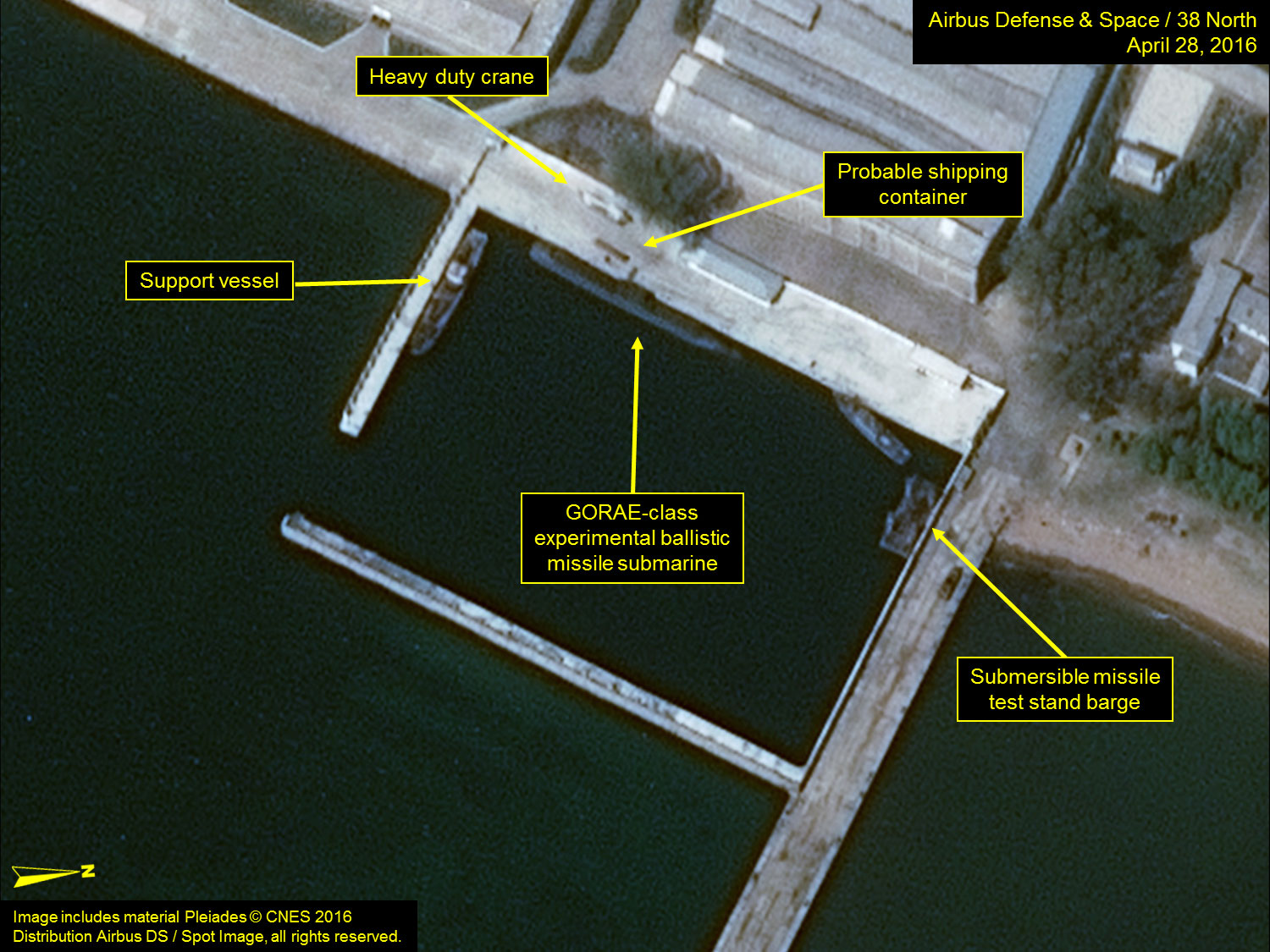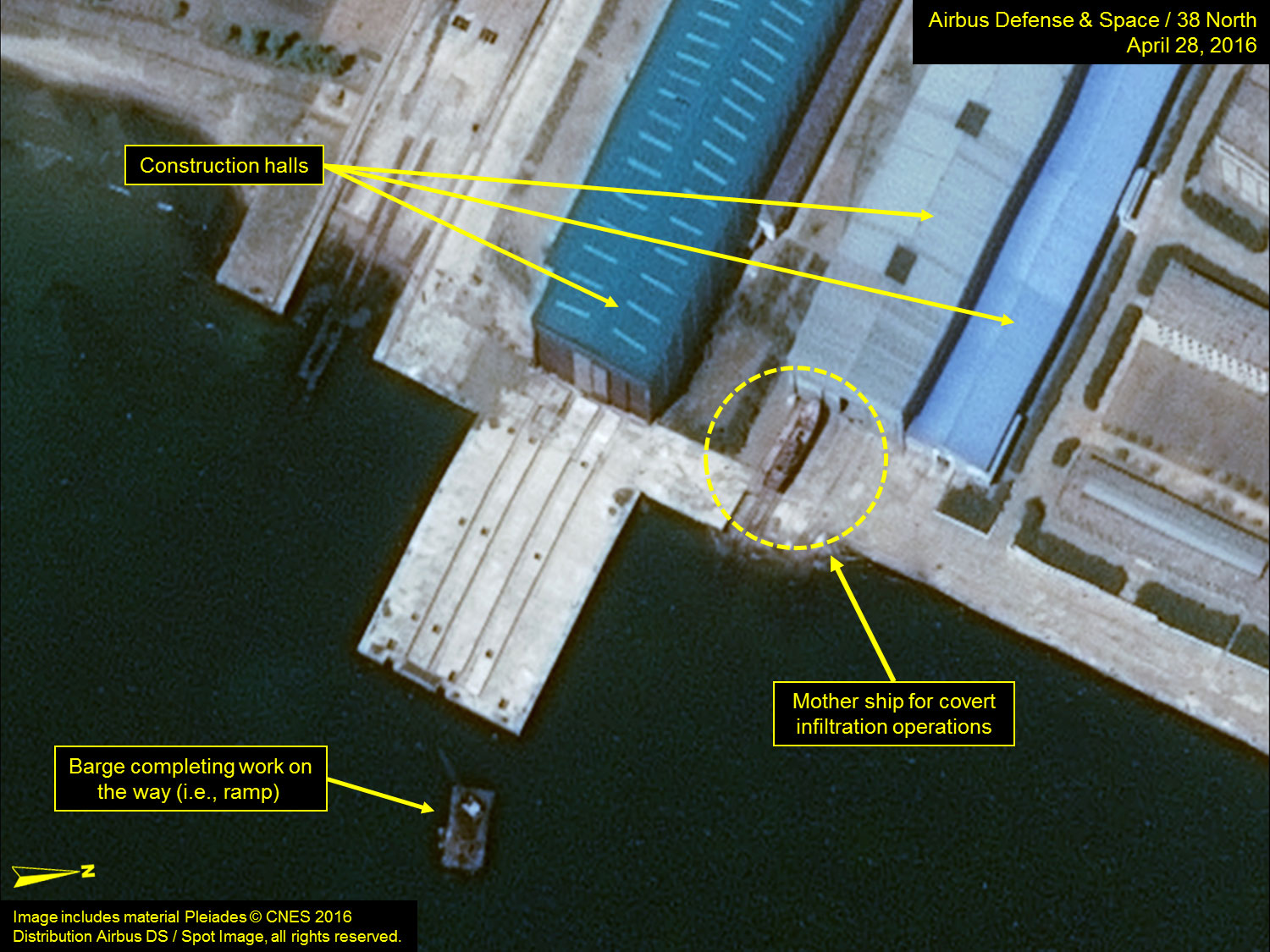03 May 2016
A 38 North exclusive with analysis by Joseph S. Bermudez Jr.
Summary
North Korea’s recent successful test launch of another Bukkeukseong-1 (Polaris-1, KN-11) submarine-launched ballistic missile (SLBM) has reinforced ongoing concerns regarding the continuing development of the missile system and the GORAE-class experimental ballistic missile submarine.
Recent commercial satellite imagery of the Sinpo South Shipyard indicates that North Korea is continuing to actively pursue development of both programs. Specifically:
- Imagery of the boat basin not only shows post-launch (maintenance) activity at the submarine but also suggests that the program may be moving towards a more advanced stage of development where the need for a submersible test stand barge has diminished. That conclusion appears to be reinforced by recent test launches from the submarine itself rather than the barge.
- The refurbishment activity at the submarine construction halls is externally complete and the extend ramp, where new boats are launched, appears almost finished. When complete, the North will be able to build and launch submarines much larger than the GORAE-class—including a new class of ballistic missile submarines.
While North Korea’s submarine-launched ballistic missile program is making progress, these activities appear in line with previous estimates that the first ballistic missile submarine and operational missiles are unlikely to become operational before 2020.
Successful Test of Submarine-Launched Ballistic Missile
On the afternoon of April 23, North Korea’s experimental GORAE-class submarine, designed to carry ballistic missiles, left its home port and cruised just a short distance into the East Sea to a point immediately off the coast. At approximately 6:30 PM, the boat conducted a successful test launch of the Bukkeukseong-1 (Polaris-1, KN-11) submarine-launched ballistic missile (SLBM). The missile travelled approximately 30 km before landing in the East Sea. The test, which follows what many sources believe was an aborted test launch a few weeks earlier, was probably intended to be limited focusing upon the submarine’s launch systems, missile ignition sequence and initial guidance operations rather than a full operational test. It is likely that there will be additional tests from the submarine this year as the North develops experience and builds toward a full-range operational test.
Post-Launch Activity at the Boat Basin
Commercial satellite imagery of the Sinpo South Shipyard taken six days after the successful test shows post-launch activity (e.g., inspection, maintenance and resupply) at the submarine. Alongside the boat is, what appears to be, a large shipping container that measures approximately 10 meters by 1.5 meters. This size is generally consistent with a missile the size of the Bukkeukseong-1. Its size and location as well as the presence of a heavy-duty crane suggest that the container may be intended to carry the missile.
Figure 1. Post-launch activity at the secure boat basin at Sinpo South Shipyard on April 28, 2016.

Image includes material Pleiades © CNES 2016. Distribution Airbus DS / Spot Image, all rights reserved. For media licensing options, please contact thirtyeightnorth@gmail.com.
Also present in the secure boat basin are the submersible missile test stand barge and two support vessels. The submersible barge has been moved from its normal position along the main dock immediately south of the submarine to the north along a secondary dock. This shift in location suggests that the SLBM program may be moving towards a more advanced stage of development where the need for a submersible test stand barge has diminished. That conclusion appears to be reinforced by recent test launches from the submarine itself rather than the barge.
A small support vessel not present in previous imagery is now visible and is docked at the north end of the secure boat basin. This vessel may be used to tow the submersible test stand barge and support the submarine during ejection tests.
Refurbishment of Construction Halls Externally Complete
Imagery indicates that the refurbishment activity at the construction halls, 400 meters to the south of the boat basin, appears to be externally complete. Construction of the expanded ramp in front of the largest hall is in its final stages. A barge appears in front of the way probably working on the underwater rails or clearing obstacles. Once the refurbishment program is finished, the North will be able to build submarines much larger than the GORAE-class—including a new class of ballistic missile submarines.
Figure 2. Construction halls appear externally complete at the Sinpo South Shipyard on April 28, 2016. (See insert for note on mother ship.)

Image includes material Pleiades © CNES 2016. Distribution Airbus DS / Spot Image, all rights reserved. For media licensing options, please contact thirtyeightnorth@gmail.com.
Vertical Test Stand Inactive
There is little activity at the vertical test stand located approximately 1,100 meters southwest of the secure boat basin used in the past by the ballistic missile submarine programs for launch tube and “pop-up” testing. The removable tower used to support tests remains in place allowing the North to more quickly conduct a “pop-up” or ejection test with little prior indications. A small vehicle is present on the stand, although no specific significance can be attached to this at present.
Figure 3. Test Stand at the Sinpo South Shipyard on April 28, 2016.





Leave a Reply